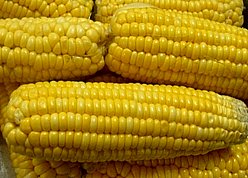There are many fruit types depending on the criteria under consideration.
The plant organ called fruit in the angiosperms may be classified according to the number of ovaries incorporated in the structure, origin of development, nature and structure of the pericarp, ability of the fruit to split apart when mature and the manner in which this occurs, and the attachment of the seed to the ovary.
According to the number of ovaries in the structure, there are three fruit types: simple, aggregate, and multiple.
Simple fruits are most common in the angiosperms.
Fruit Types According to Origin of Development

Based on the flower parts from which fruits develop, they are classified as simple, compound and accessory fruits.
Compound fruits are further subclassified into aggregate and multiple fruits.
1. Simple fruits are composed of a single ovary which may be simple or compound.
A simple ovary has one carpel while a compound ovary has two or more fused carpels.
Common types belonging to simple fruits that are developed from a simple ovary are follicle, legume, and nut.
The capsule, schizocarp, and silique are developed from a compound ovary or pistil.
2. Aggregate fruits develop from separate ovaries of a single flower fused together, as in plants belonging to the genus Annona (e.g. soursop, sugar apple, custard apple, cherimoya).
The fruits of these plants are also called syncarps.
In the strawberry, the individual fruits are one-seeded dry fruits (i.e. achene) embedded in a receptacle at a single point.
The fleshy, edible portion is the receptacle.
In thimbleberry (Rubus parviflorus), the fruit consists of small, one-seeded drupelets which develop from separate ovaries within the same flower.
3. Multiple fruits develop from many separate but closely clustered ovaries of different flowers on the same inflorescence, usually with a central core consisting of a thickened axis of the inflorescence or receptacle, e.g. pineapple, jackfruit, bread fruit, mulberry, and the corn ear (cob with attached kernels).
4. Accessory fruits are fleshy fruits that contain other plant tissues in addition to the ovary.
They may include a succulent receptacle or other accessory parts of a flower.
Included with this fruit type are the pome, pepo, and most aggregate and multiple fruits.
Dehiscent vs. Indehiscent Fruits
a. Indehiscent fruits – the pericarp remains close, usually one-seeded, e.g. achene, anthocarp, caryopsis, samara, nut, schizocarp, utricle, fleshy fruits.
b. Dehiscent fruits – splits open at maturity, usually two- to many-seeded, e.g. capsule, follicle, legume, silique.
Dry vs. Fleshy Fruits
1. Fleshy Fruits – with a pericarp that is more or less fleshy at maturity, e.g. berry, pepo, hesperidium, drupe, pome, aggregate fruit, multiple fruit.
2. Dry Fruits – with a pericarp that is dry and hard or papery at maturity, e.g. achene, anthocarp, caryopsis, samara, nut, schizocarp, utricle, capsule, follicle, legume, silique.
